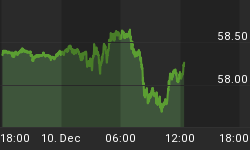Below is an excerpt from a commentary originally posted at www.speculative-investor.com on 27th April 2014.
The boom/bust cycle is caused by fractional reserve banking. Rather than eliminate this practice, that is, rather than prevent the commercial banks from creating money out of thin air, central banks were established to 'backstop' the commercial banks. This paved the way for longer booms and more severe busts. Gold tends to do relatively well during the busts and relatively poorly during the booms.
Gold's tendency to gain value during the bust phase and lose value during the boom phase is sometimes not readily apparent from the performance of the dollar-denominated gold price. This is because currency depreciation will sometimes cause the US$ gold price to rise along with most other commodities during booms and because a desperate flight to cash can cause the US$ gold price to fall along with other commodities during the initial stage of a bust. However, the gold/commodity (g/c) ratio usually paints an accurate picture, with the ratio typically having a downward bias during booms and rising sharply throughout the ensuing busts.
The relationship outlined above is illustrated by the following 20-year chart of the g/c ratio. The chart shows that since early-2001 gold has worked its way higher relative to commodities in general (represented by the CCI) via a series of leaps separated by multi-year periods of downward or sideways trading. Not coincidentally, the long, erratic climb began shortly after a major peak in the US stock market. Also not coincidentally, each of the leaps in the g/c ratio has happened in parallel with major economic problems and/or systemic crises. Between these periods of crisis there was rising economic and financial-system confidence. The result, in each case, was a lacklustre or poor performance by the g/c ratio.

The most recent peak in the g/c ratio (an all-time high) happened in mid-2012, at around the same time as fears of euro-zone sovereign debt default and monetary-union collapse were peaking. The ratio has since trended downward in parallel with rising confidence in central banking and increasing optimism about economic growth prospects in Europe and the US. Some indicators, such as the yield-spread and credit spreads, are warning that the trend of the past two years has ended, but a trend change hasn't yet been confirmed by the g/c ratio.
A break above the blue line on our g/c chart (the 50-week MA) would be confirmation of a major trend change.
We aren't offering a free trial subscription at this time, but free samples of our work (excerpts from our regular commentaries) can be viewed at: http://www.speculative-investor.com/new/freesamples.html
















